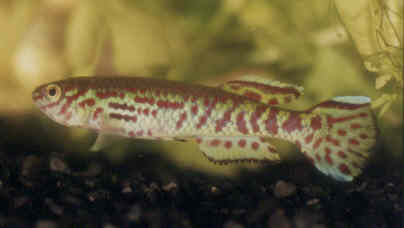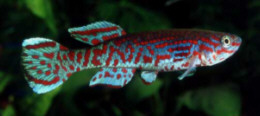Fundulopanchax gardneri mamfensis (Radda 1974)

Form circulating in the BKA in the early 1980's.
| Meaning of Name |
Refers to the Mamfe plains. |
||||||
| First Description |
Radda A.C. 1974. (Aphyosemion gardneri mamfense). Studien zur Cytogenetik, Taxonomie und Verbreitung der 'Gardneri-Gruppe' der Gattung Aphyosemion (Osteichthys, Cyprinodontidae) aus dem südlichen Westkamerun. Jahrbuch des Naturhistorisches Museums der Stadt Bern 5: p 6-8, figure 3. |
||||||
| Size |
48.5 mm (according to the original description). |
||||||
| Meristics |
D = 13-15, A = 15-16, D/A = +5-6, ll = 32-33 +3 (Radda 1974). |
||||||
| Karyotype |
n = 20, A = 34 (Radda 1974) |
||||||
| Sub-Genus |
Paraphyosemion |
||||||
| Group |
gardneri |
||||||
| Synonyms |
|
||||||
|
Mamfe - Mile 5, CB3SR 07-19 Mfuni - Clear anal fin with feint dark
outer rim . Lower submarginal band in caudal fin lacks integrity.
N'Debaya - Scheel reported this population in ROTOW II as having 2 red bands in the caudal fin. Rosary Hill - Seen on Alf & Anita Persson's site 2006. I can find no information on this one - possibly a Catholic Mission. Satom - Collected in 2015 (CVGPM 15 / 9). Can be split into yellow & blue phases.
|
||||||
| Type Locality |
3 km south of Bachou-Akagbé on the road to Manyemen. The biotope was near the mouth of a brook which emptied into a larger river. |
||||||
| Distribution |
Restricted to the rainforest of the Mamfé plains in the upper Cross River drainage system. Click link to map of gardneri distribution. This comprises all populations I can find on maps. You can zoom in but markers are not accurate to the exact collection spot, just the area which builds up a picture of distribution. map |
||||||
| Habitat |
Shallow areas of pools & brooks. |
||||||
| Distinguishing Characteristics | Most populations (Ossing, Mamfé etc) can be distinguished from other Fp.gardneri subspecies by heavy red blotches over the body & un-paired fins. | ||||||
| Colour/Pattern Variability | Fairly High considering the limited distribution area. Their is a marked difference in populations from Mamfé & Ossing. The later being more strikingly patterned. | ||||||
| History |
In early collections of Fp.nigerianus
Scheel became aware of a different looking fish in the east of Nigeria
on the Nigeria/Cameroon border east of the Lower Cross River. These
were referred to as 'A.gardneri from
Ndian River'. This is mamfense country. In 1970 a blue phase mamfense was found near Besongabang. This fish was described as being heavily spotted in the body & un-paired fins. The early part of the '70's saw the introduction & distribution of a fish called Aphyosemion 'Mini-Killie'. They were reported to have been collected by Mr. Kluge of Hamburg in Nigeria. See also Eymojok & Fp.gardneri gardneri. First introduction of the fish known as 'mamfense' into the BKA was probably in 1973. In November/December 1998 Jack Heller, Nevin Aspinwall & Tomas Heller of the AKA collected them at Ebinsi, Cameroon. These were distributed as HAH 98/Ebinsi.These were still around at the 2000 AKA Convention. |
||||||
| Breeding Notes |
When first introduced into the UK they proved
to be very reluctant spawners with best results coming from pairs which
layed eggs in a sand substrate. |
||||||
| Diameter of Egg |
1.2 mm. |
||||||
| Remarks |
This subspecies mainly comprises blue phenotypes but Ossing has been seen as yellow & blue. |


